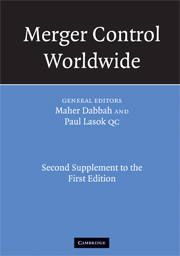Book contents
- Frontmatter
- Contents
- List of contributors
- Table of cases
- Table of legislation
- Introduction to the Second Supplement
- Introduction to the First Supplement
- 1 Argentina
- 2 Armenia
- 3 Australia
- 4 Austria
- 5 Belgium
- 6 Brazil
- 7 Canada
- 8 Chile
- 9 China
- 10 Denmark
- 11 European Union
- 12 Germany
- 13 Greece
- 14 Iceland
- 15 Italy
- 16 Japan
- 17 Republic of Korea
- 18 Malta
- 19 Mexico
- 20 The Netherlands
- 21 New Zealand
- 22 Norway
- 23 Singapore
- 24 Spain
- 25 Switzerland
- 26 Taiwan
- 27 Ukraine
- 28 United Kingdom
- 29 United States of America
- Index
2 - Armenia
Published online by Cambridge University Press: 30 July 2009
- Frontmatter
- Contents
- List of contributors
- Table of cases
- Table of legislation
- Introduction to the Second Supplement
- Introduction to the First Supplement
- 1 Argentina
- 2 Armenia
- 3 Australia
- 4 Austria
- 5 Belgium
- 6 Brazil
- 7 Canada
- 8 Chile
- 9 China
- 10 Denmark
- 11 European Union
- 12 Germany
- 13 Greece
- 14 Iceland
- 15 Italy
- 16 Japan
- 17 Republic of Korea
- 18 Malta
- 19 Mexico
- 20 The Netherlands
- 21 New Zealand
- 22 Norway
- 23 Singapore
- 24 Spain
- 25 Switzerland
- 26 Taiwan
- 27 Ukraine
- 28 United Kingdom
- 29 United States of America
- Index
Summary
Economic growth
In relation to the economic growth in Armenia, GDP growth rate has been at double-digit levels since 2002; real GDP growth for 2002 was 13.2%, for 2003 14%, for 2004 10.1%, for 2005 13.9%, and for 2006 13.3%.
Relevant legislation and statutory standards
The Constitution of the Republic of Armenia was amended in 2005. Article 8(2) of the new version of the Constitution stipulates that the “Republic of Armenia guarantees freedom of economic activity and free economic competition”.
The Law of the Republic of Armenia on Protection of Economic Competition (the “Law”) provides a first fundamental regulatory framework for competition assessment of economic entities in commodity markets. It prohibits concerted practices and abuse of a dominant position, regulates mergers, and deals with unfair competition and consumer protection issues, as well as state aid. It is largely aligned with the rules of the European Community (EC), in particular with those of the EC Treaty.
Decision-making bodies and enforcement authority(ies)
One of the important amendments to the Law, introduced as recently as 22 February 2007, is the granting of the right of inspection to the Commission, which will essentially enhance the powers of the Commission in terms of supervising the competitive environment. This right of inspection is expected to cause new problems for the Commission however. The Commission is not institutionally well developed and problems in relation to the internal distribution of powers of inspection within the Commission and human resources are likely to arise.
- Type
- Chapter
- Information
- Merger Control WorldwideSecond Supplement to the First Edition, pp. 9 - 14Publisher: Cambridge University PressPrint publication year: 2008

